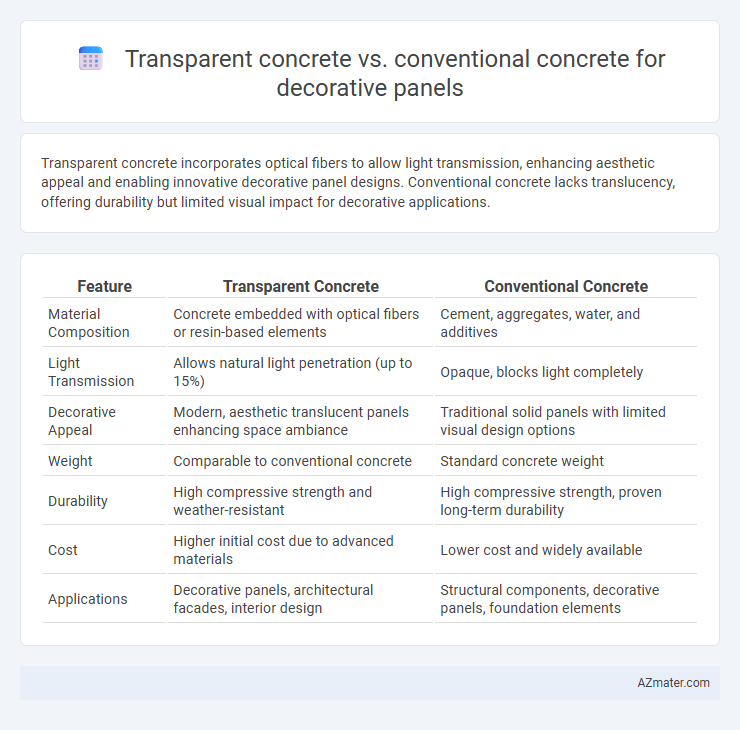Transparent concrete incorporates optical fibers to allow light transmission, enhancing aesthetic appeal and enabling innovative decorative panel designs. Conventional concrete lacks translucency, offering durability but limited visual impact for decorative applications.
Table of Comparison
| Feature | Transparent Concrete | Conventional Concrete |
|---|---|---|
| Material Composition | Concrete embedded with optical fibers or resin-based elements | Cement, aggregates, water, and additives |
| Light Transmission | Allows natural light penetration (up to 15%) | Opaque, blocks light completely |
| Decorative Appeal | Modern, aesthetic translucent panels enhancing space ambiance | Traditional solid panels with limited visual design options |
| Weight | Comparable to conventional concrete | Standard concrete weight |
| Durability | High compressive strength and weather-resistant | High compressive strength, proven long-term durability |
| Cost | Higher initial cost due to advanced materials | Lower cost and widely available |
| Applications | Decorative panels, architectural facades, interior design | Structural components, decorative panels, foundation elements |
Introduction to Transparent and Conventional Concrete
Transparent concrete incorporates optical fibers or resin-based materials to allow light transmission, enhancing aesthetic appeal and natural illumination in decorative panels. Conventional concrete, composed primarily of cement, aggregates, and water, offers structural strength and durability but lacks translucency, limiting creative design options. The integration of transparency in concrete panels merges functional robustness with innovative visual effects, distinguishing it from traditional opaque materials.
Composition Differences: Transparent vs Conventional Concrete
Transparent concrete incorporates optical fibers or resin-based polymers within its cement matrix, enabling light transmission through the material, while conventional concrete consists primarily of cement, water, aggregates, and additives, lacking any light-conductive components. The inclusion of polymer materials or optical fibers in transparent concrete not only affects its translucency but also influences its mechanical properties and durability compared to the dense, opaque structure of conventional concrete. This fundamental compositional difference results in transparent concrete being suitable for decorative panels that require aesthetic illumination effects, unlike conventional concrete which focuses on strength and opacity.
Light Transmission Properties
Transparent concrete exhibits superior light transmission properties compared to conventional concrete, allowing up to 70% of ambient light to pass through due to embedded optical fibers. Conventional concrete blocks most light, typically transmitting less than 5%, resulting in opaque, solid panels. The enhanced translucency of transparent concrete makes it ideal for decorative panels where natural lighting and aesthetic appeal are prioritized.
Structural Performance Comparison
Transparent concrete incorporates optical fibers that enhance light transmission while maintaining comparable compressive strength to conventional concrete, typically ranging between 20-40 MPa. Conventional concrete exhibits higher structural rigidity and load-bearing capacity, but lacks translucency, limiting its decorative appeal in panels. Transparent concrete offers unique aesthetic benefits with sufficient durability for non-load-bearing decorative panels, whereas conventional concrete remains the preferred choice for structural applications due to its superior mechanical properties.
Aesthetic Possibilities for Decorative Panels
Transparent concrete offers unique aesthetic possibilities for decorative panels by incorporating optical fibers that transmit light, creating dynamic and visually engaging surfaces that change with lighting conditions. Conventional concrete lacks this light-transmitting capability, limiting design options to texture and color variations without illumination effects. The innovative translucency of transparent concrete enables architects and designers to achieve striking visual depth and enhanced ambient lighting in interior and exterior panel applications.
Energy Efficiency and Sustainability
Transparent concrete enhances energy efficiency in decorative panels by allowing natural light to penetrate interior spaces, reducing the need for artificial lighting and lowering energy consumption. Unlike conventional concrete, which is opaque and requires additional lighting, transparent concrete features embedded optical fibers or resin-based materials that maintain structural integrity while promoting daylighting. This innovative material contributes to sustainability by reducing reliance on electrical power and minimizing carbon emissions linked to lighting, making it a superior choice for eco-friendly architectural designs.
Installation and Maintenance Considerations
Transparent concrete panels offer easier installation due to their lighter weight and integrated lighting elements, reducing the need for additional electrical work compared to conventional concrete. Maintenance for transparent concrete involves careful cleaning to preserve light transmission and prevent discoloration, unlike conventional concrete panels that primarily require surface sealing to resist stains and weathering. Choosing transparent concrete enhances aesthetic appeal with minimal added installation complexity, while conventional concrete panels demand routine upkeep focused on structural integrity and surface protection.
Cost Analysis and Economic Impact
Transparent concrete, incorporating optical fibers, generally incurs higher initial costs compared to conventional concrete due to specialized materials and complex manufacturing processes. Despite its premium price, transparent concrete offers long-term economic benefits through enhanced aesthetic appeal and energy efficiency in decorative panels, potentially increasing property value. Conventional concrete remains more cost-effective for large-scale projects but lacks the unique visual and functional advantages that justify the investment in transparent options for high-end architectural applications.
Applications in Modern Architecture
Transparent concrete, incorporating optical fibers or light-transmitting elements, enables natural light diffusion while maintaining structural integrity, making it ideal for decorative panels in modern architecture. Conventional concrete, although durable and cost-effective, lacks light transmission properties and is primarily used for load-bearing and aesthetic surfaces without illumination effects. Innovative designs leverage transparent concrete panels for energy-efficient facades, interior partitions, and artistic installations, enhancing visual appeal and reducing reliance on artificial lighting.
Future Trends in Decorative Concrete Panels
Transparent concrete integrates optical fibers or resin-based light-transmitting materials, offering innovative aesthetic possibilities and enhanced natural lighting in decorative panels. Future trends emphasize smart integration, including dynamic light modulation and embedded sensors, elevating the functionality and visual appeal beyond conventional concrete's opaque, static design. Research focuses on improving durability and cost-efficiency to widen application in sustainable architecture and interior design.

Infographic: Transparent concrete vs Conventional concrete for Decorative panel
 azmater.com
azmater.com